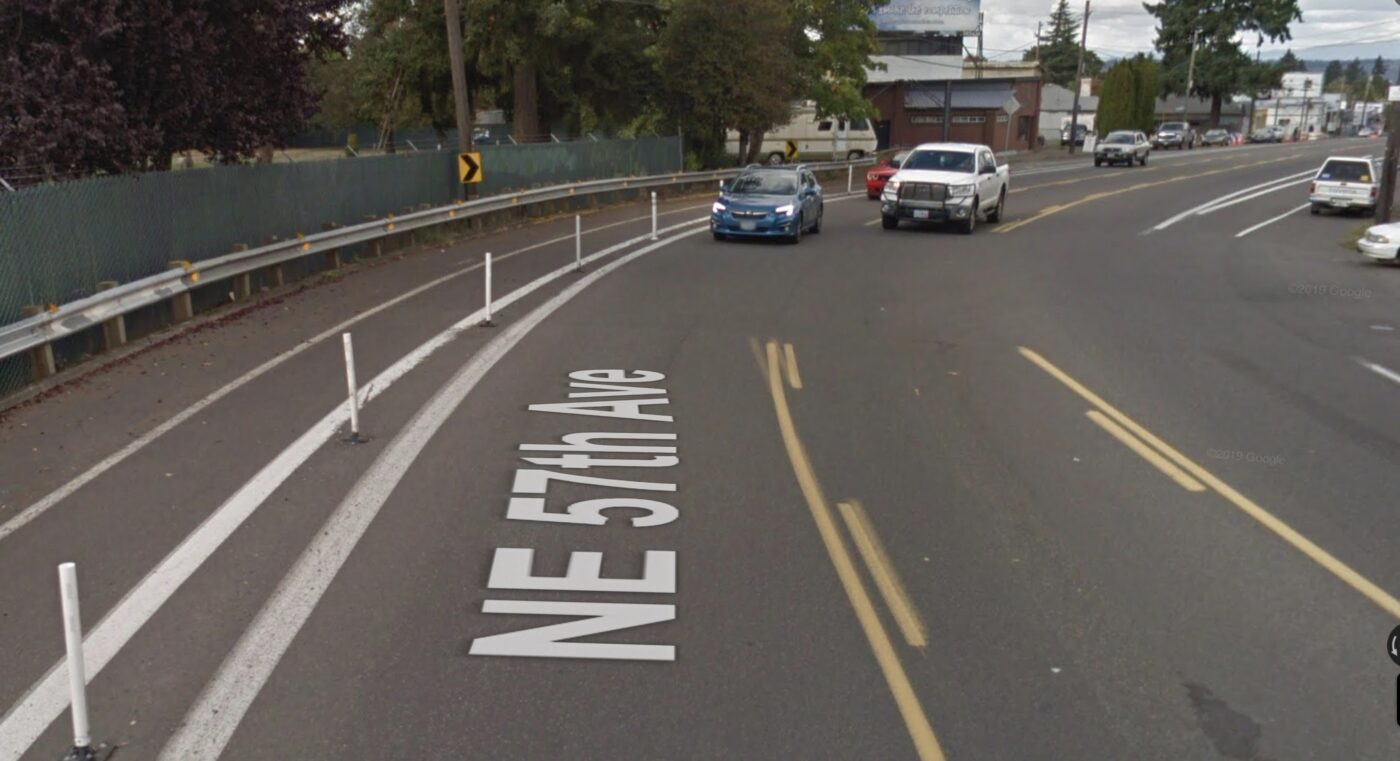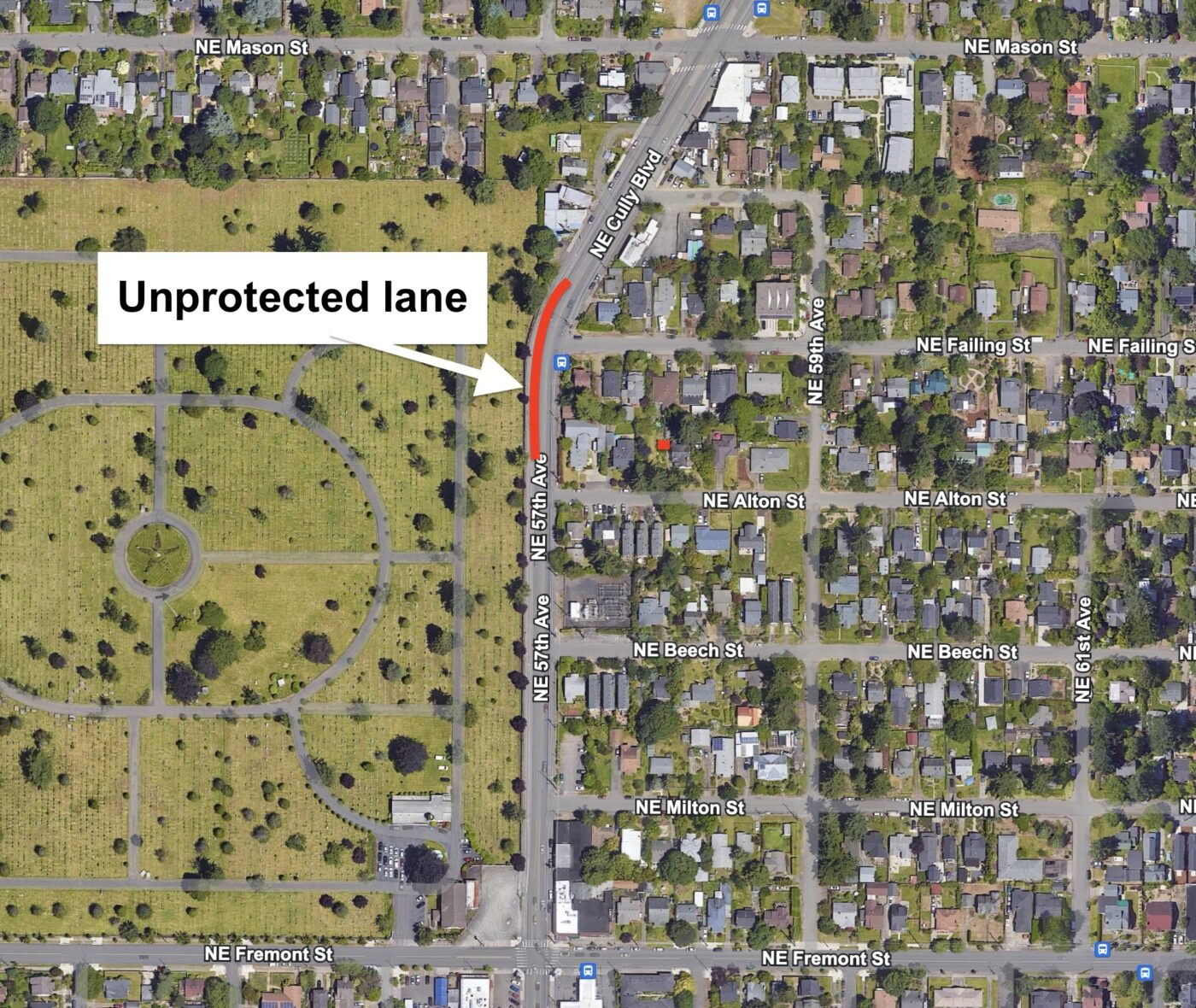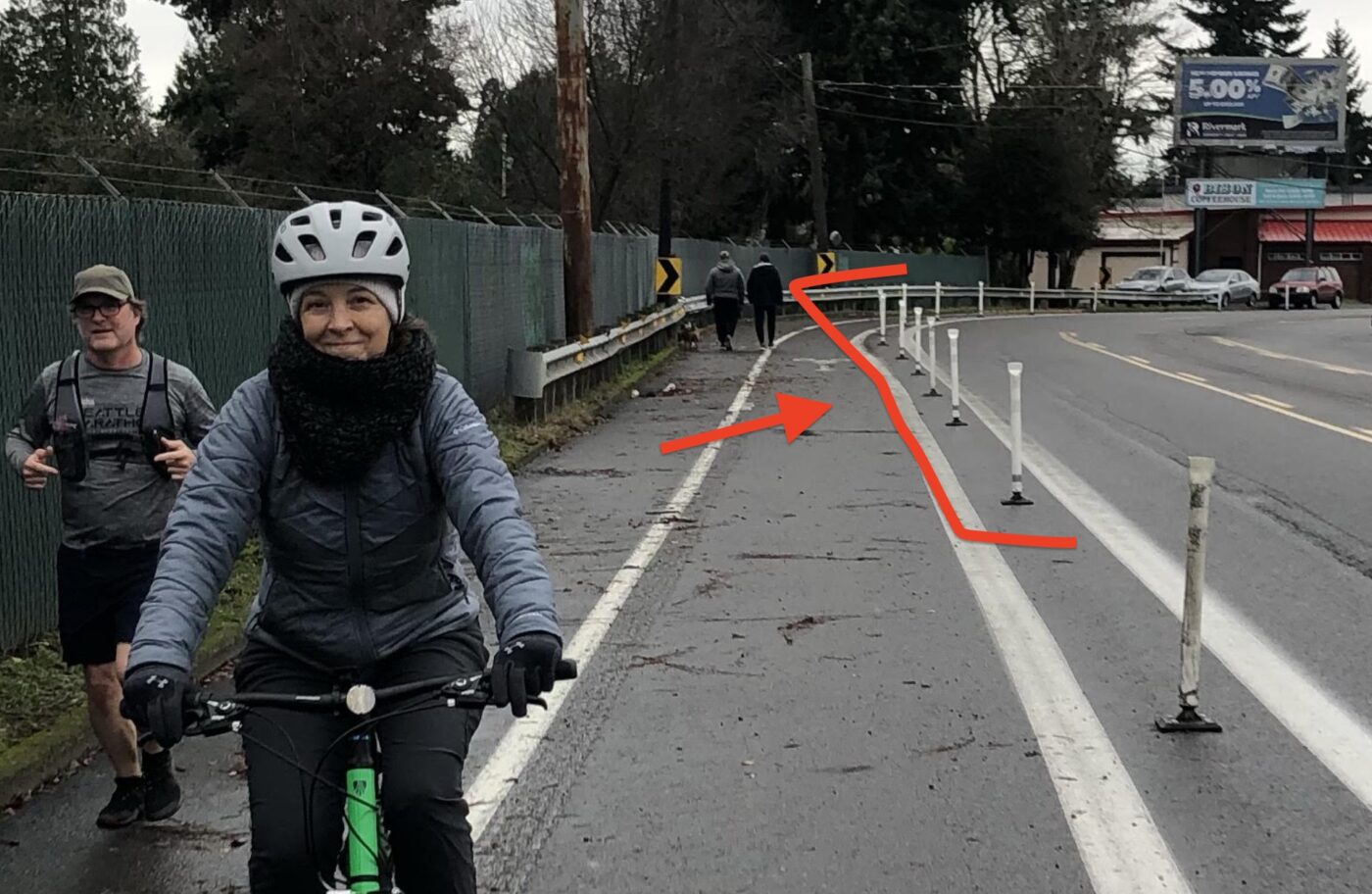
UPDATE, 12/10: PBOT has replaced the missing plastic wands. Reader Joseph E. sent in a pic that you can see at the end of this story.
A few weeks ago I received an email from Mark Falbo, a Portlander who grew up in the Cully neighborhood over sixty years ago. Mark told me about a safety concern on NE 57th/NE Cully Blvd where it curves just north of NE Fremont. He said dozens of white, plastic delineator wands installed by the Portland Bureau of Transportation to protect bicycle riders and walkers, had gone missing.
“They have all been eliminated from cars and trucks running over them,” Mark wrote. “It’s a very dangerous corner to ride a bicycle through because of its history of people running into the chain-link fence after crossing the bike lane.” Mark had seen the video of the horrific collision on NE 21st that led PBOT to install concrete barricades to protect the bike lane. “As with the dangerous situation faced on NE 21st, this particular corner in Cully warrants immediate action by PBOT to prevent a very likely accident.”
When I rolled over on Sunday, I found out Mark had every reason to be concerned. I counted 19 plastic wands that were no longer standing in the buffer zone of the southbound bike lane on each side of the “T” intersection with NE Failing. The result is a bike lane that is unprotected from car drivers — just as they negotiate a curve at around 30 mph (speed limit is 25 mph).









From what I’ve learned, PBOT first installed plastic wands between NE Failing and Fremont in 2017. That’s also when they added width and the buffer zone to the southbound bike lane by removing an on-street parking lane on the northbound side of the street and shifting the lane striping east. I’m not sure how long the bike lane has been left unprotected. They’re all missing in a Google Maps image dated October 2023 and readers have shared that they might have been gone as far back as summer (more on that below).
NE 57th in this area is classified as a Bicycle Parkway (“a bicycle route designed to serve as a bicycle highway providing for direct and efficient travel for large volumes of cyclists”) and Pedestrian Parkway (“high quality and high priority routes for pedestrian activity”) in the Regional Transportation Plan (RTP). It’s a vital north-south connection between retail destinations around Fremont and along NE Cully to the north. When PBOT added space for non-drivers around 2017, they also add a “pedestrian walkway” southbound — a rare treatment that gives space to walkers on the road, instead of a sidewalk separated by a curb. The presence of this walkway should add even more urgency to the lack of protection, as they are/were the only physical separation between walkers and car users.
This location is already squarely on the PBOT radar (or at least it should be). In 2016 a man was killed by a driver as he tried to walk across 57th at NE Mason, just two blocks north of the curve. Following that tragedy, the neighborhood demanded immediate safety investments. In a letter to the Commissioner of PBOT, the Cully Association of Neighbors wrote, “This stretch of Cully Boulevard, between Fremont and Prescott Streets, is particularly hazardous. It is quite wide, encouraging speeds well above the posted 30 MPH, and a blind curve just south of Mason Street invites crashes like this one.” PBOT has since built a new marked crossing with a concrete center median at the Mason intersection where the person was killed. Four years earlier, in 2012, BikePortland identified this section of 57th as a perfect location for a physically protected bike lane.



To their credit, PBOT listened to neighbors and applied for a federal grant through Metro’s Regional Flexible Funds Allocation (RFFA) process. In October 2022 they were awarded $7.6 million for the Cully/57th Complete Street Project. The project will build a real sidewalk on the west side of the street and widen the existing one on the east side (see cross-section drawing above). The project will also narrow the street (which ranges from 65-75 feet today), build new crossings at NE Failing and Skidmore, install a transit island at NE Mason, rebuild and update the signal at Fremont, and add protected bike lanes that will have a concrete curb instead of plastic wands.
That’s great news, but that project isn’t estimated to begin construction until 2027 (federal funding is a bummer that way). So for now, we’ve got to address the conditions on the ground.
While out there on Sunday, it was easy to see that many drivers fail to negotiate the turn. There was clear evidence of a recent crash. The guardrail was bent and shoved up against the fence and its wooden supports were splintered and sheared clean off their bases.
As for what might have happened to all the missing plastic wands, it’s likely drivers hit them and ripped them out. It’s also possible that City of Portland crews purposely removed them and never put them back. Two readers familiar with the location recalled a Water Bureau sewer repair project that opened up the street this past summer where crews took the wands out in order to make room for a detour route.
Today there are at least a dozen of the wands stashed behind the guardrail (which is doing a great job protecting the fence, when it could be in the street protecting the bike lane!). The wands are strewn about, discarded like wounded soldiers unable to perform their duties.
I’ve asked PBOT for more information about this location and will update this post when I hear back.
Regardless of what happened here, this is a pattern we see citywide far too often. Think of the situation on NE 21st, the NW Lovejoy ramp back in 2012, on NW Naito, and so on and so forth. Like I shared in an op-ed in 2016, if we want cycling to be taken seriously, we must build serious cycling infrastructure.
Plastic wands on busy, high-speed streets are not a serious solution. And allowing them to be ripped out so easily and then leaving people exposed to dangerous drivers for months on end is unacceptable.
BikePortland reader Barbara Stedman told us via social media about what’s happening near her home in southwest. “When they put up the bollards on Beaverton-Hillsdale Highway between 25th and Bertha, the bollards were mowed down by cars immediately. Some days PBOT would put up new ones in the morning and they were gone by the afternoon.”
“People living close could hear the bang-bang-bang of car mirrors hitting the bollards,” Stedman continued. “In some places PBOT gave up, on others they added a concrete curb to it. That works much better.”
— If you see protected bike lanes where plastic wands, bollards, or other protective elements have gone missing, PBOT urges you to call their 24/7 maintenance dispatch hotline at (503) 823-1700.
Video from our Instagram page below. Follow us there at @BikePortland.




